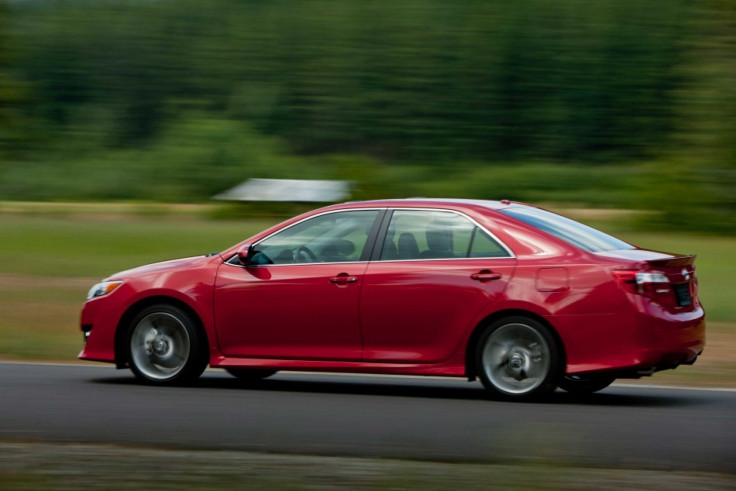Win On Sunday, Sell On Monday: The Theory Behind NASCAR's Big Racecar Redesign [PHOTOS]

NASCAR fans are car fans, and the racing league and manufacturers like Toyota Motors Corporation (NYSE: TM) that compete in the Sprint Cup Series are betting that some design tweaks can energize that fandom as well as dealership sales. NASCAR and the car companies are in the process of a redesign to make the racecars look a whole lot more like production cars that fans can buy off the lot. The redesign is geared partly to improve brand visibility for carmakers, partly to improve fan engagement in the sport. NASCAR and the manufacturers hope to create fans of brands instead of just fans of particular drivers.
The 2013 Camry will very definitely come closer to resembling the production car, Les Unger, national motorsports manager for Toyota said. From a visual perspective, it makes it more fun to watch races where the cars look like production cars, he said.
The 2013 Toyota Camry racecar is just the latest car to be revealed with the redesign. All four manufacturers (Toyota, Ford Motor Company (NYSE: F), General Motors Company's (NYSE: GM) Chevrolet brand, and Chrysler Group LLC's Dodge brand), that compete in the NASCAR Sprint Cup were involved in the redesign effort. Ford, Dodge and Toyota have already revealed their redesigns, and Chevrolet's will be debuted later this season. The redesign was an all-or-nothing affair: All the manufacturers had to get behind it or or it wouldn't happen for any of them. Toyota, Ford, GM and Chrysler all decided that the engineering expense of redesigning the cars was worth it.
I think it's unprecedented that the manufacturers would go this deep into developing a racecar, said Robin Pemberton, vice president of competition for NASCAR. While the confluence of interest between the car companies and NASCAR is opportune, the burden on the manufacturers is fairly slight. Toyota, for its part, tasked its U.S. design studio to adapt the sale version of the 2013 Camry to the racetrack.
The redesign is not what you would refer to as 'dramatic', Unger said, because it is largely cosmetic.
All of the cars in the NASCAR Spring Cup Series must meet the same safety standards, and the strength of one car over another largely rests with the teams and proprietary adjustments they make to vehicle suspension and other tuning changes. If you're a racecar driver, you probably don't care what the car looks like on the outside so long as it wins the race, Pemberton said.
The redesign of the cars was fundamentally driven by the twin desires of enhancing fan involvement in the sport and selling more cars during the week, big motivators for both NASCAR and the car companies. The goal was to redo the cup cars with a production theme, a production car look, according to Pemberton, to energize fans and re-engage manufacturers in the sport.
NASCAR's design tweaks were carried out to bolster the motorsport's Win on Sunday. Sell on Monday. mentality. The thinking goes that the more the racecars look like production cars, the more likely racing fans are to buy them next time they are considering a new car.
Fans want to drive a car that looks an awful lot like what they watch race, Pemberton said, adding that it was good for dealership networks to show a car the manufacturer is racing on the weekend.
To make the racecars look more like production cars, the manufacturers' design studios have focused on bringing their shape and dimensions of the front ends, side character lines and rear bumper corners more in line with those on the production models, according to Unger. The redesign process began in December 2010, and NASCAR is expected to give its final approval in June or July.
While there is not a direct linkage between how the racecars look and sales, the fact that NASCAR fans buy cars based on their allegiances is fairly well established. NASCAR has a fan base of roughly 75 million.
Thirty-five percent of new car intenders [i.e. consumers planning to buy new cars] are motorsports fans, and 78 percent of motorsports fans follow NASCAR, said Tim Duerr, Ford Racing's motorsports marketing manager. Nearly 70 percent of Ford Racing fans will consider one of our products.
And that was before the redesign. NASCAR and the manufacturers are hoping the racecar redesign will help foster a greater sense of competition between the brands and not just the racing teams. Currently, most fans are fans of a specific team instead of a brand of car, but that has not always been the case. NASCAR was dominated by brand-based fans in the late 1980s and early 1990s, according to Pemberton, when rivalries among Ford, Chevy and Pontiac ran deep. The manufacturers and NASCAR are hoping that the redesign will once again play a role in creating brand-specific fans, and that this will make the racing more exciting.
I think the [value of the redesign] is based on the fact that I think the fans wanted to get back in and engage with the automobiles that we race, Pemberton said. One way to do that is to make the racecars look more like the production cars on dealer lots, or so the thinking goes. But it remains to be seen whether the redesigned racecars will make production cars winners on the car lots.
At the end of the day, basically our involvement in NASCAR is increasing the awareness that Toyota is part of the biggest motorsport in the country, Unger said. From a branding perspective, it is always beneficial to have a car competing, particularly in stock car racing.
© Copyright IBTimes 2024. All rights reserved.




















